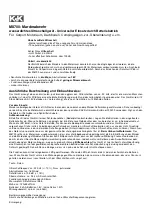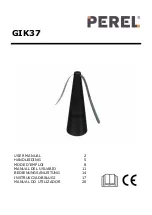
17 of 20
Special Applications
Spring Washers for Temperature Extremes: To avoid re-torquing the cover nuts/bolts in
exceptionally hot or cold applications, Belleville spring washers can be used under the
nut or bolt heads to maintain gasket loading. It is best to return the gage to a factory
authorized repair center to add spring washers since they must be assembled in the
proper orientation and, in most cases, longer bolting is required.
Shields for Protection from Chemical Attack: Transparent gage glasses used with fluids
corrosive to glass require the protection of PCTFE (formerly Kel-F®) or mica shields
(shields can’t be used with Reflex type glass gages). Mica shields are installed
between the glass and the gasket on the process side. PCTFE shields are to be
installed as follows:
1. Install the PCTFE shield in the gage between the chamber and glass (the
PCTFE shield acts as both a gasket and a shield - no separate sealing gasket is
required).
2. Reassemble the gage to the required torque value in the proper sequence (new
glass and cushion gaskets are required – see Repairing a Flat Glass Gage for
more details).
3. Let the gage sit for 10-12 hours.
4. Re-torque to the original torque value in the proper sequence.
5. Repeat steps 3-4 if needed to prevent leakage.
Vacuum Service: All glass gages are suitable for use in vacuum service, provided the
gage assembly does not include a PCTFE shield. See valve IOM for provisions for
vacuum service with valves.
High / Low Temperature Service: To prevent thermal gradients from stress-loading the
glass or possibly relaxing the gasket clamping load and causing leaks, uniformly
insulate the gage to help ensure that all components remain at the same temperature.
Operation in Low Temperature Service: To prevent thermal shock, bring the gage into
service slowly. Crack open the shutoff valves carefully, then wait until the gage has
cooled down before opening fully. Do not isolate the gage when cold. The fluid within
will warm up, internal pressure will increase and the glass may break. Either let the
gage warm up with the system after shutdown or, if it must be isolated from the vessel,
vent it to atmosphere.



































